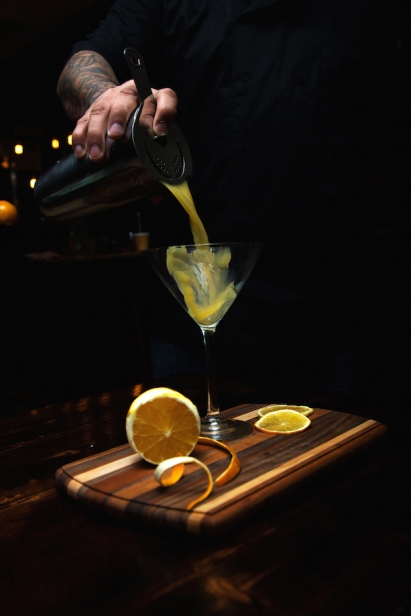A Bronx Cocktail Tale
You know those old movies where tuxedoed men and diamond-draped women exchange rapid-fire quips as harried waiters rush fresh drinks around a glitzy hotel bar? Chances are the cocktail those glamorous tipplers are imbibing is the Bronx—the Bronx cocktail.
Long neglected but certainly not forgotten, the Bronx was second only to the Martini and the Manhattan in barroom popularity a century ago. Although some beverage historians and early newspaper accounts say the drink was first crafted by a borough expat in Philadelphia, prevailing speculation credits its birth to a cocktail artisan in a setting more like the scene set above: the Waldorf Astoria New York.
At the dawn of the 20th century, a Waldorf waiter challenged his barman to create a new drink. The bartender, having just poured the then-popular Duplex cocktail—dry vermouth, sweet vermouth and a dash of orange bitters—duplicated the order but added gin and orange juice. It was an instant hit. Pressed for a name, the barman spied some unruly guests who looked better suited as caged displays. Thus the Bronx was named in honor of the newly opened zoo, explained Frank Caiafa, bar manager of Waldorf Astoria New York.
Sherry-based cocktails like the Adonis and the Bamboo were popular at the time, as well as more potent usual suspects like the Scotch whiskey–based Rob Roy and Robert Burns. But they had nothing on the Bronx.
Sometimes called the Cosmopolitan of its day, the Bronx was one of the most requested cocktails prior to Prohibition. And that era’s 18th Amendment might have even made it more popular: A juice-heavy blend—sometimes called a Jazz—would help the speakeasy age’s less-refined gin go down easier. Other variations abound. A Cooperstown is a Bronx shaken with a sprig of mint; a Silver Bronx features an egg-white froth; and a Cuban Bronx swaps white rum for gin. A Dry Bronx omits the sweet vermouth, while the Widow omits the dry. Caiafa lists these and more in his 2016 update of The Waldorf Astoria Bar Book, first published in 1934.
“The first versions found in print listed the Bronx as an orange juice–enhanced ‘perfect’ Martini—two parts dry gin, one part split between both sweet and dry vermouth, with a bar spoon or two of fresh OJ, stirred and served up,” Caiafa told Edible Bronx. “Worth a try, though most will return to the popular lunchtime quencher that the Bronx was meant to be. Don’t overlook serving it on the rocks as your new brunch staple as well.”
So what happened to this staple aperitif? Nothing stays fashionable forever. Our boozy brunches switched to Bloody Marys, Screwdrivers and Mimosas because vermouth fell out of fashion. Dramatically so. You’ll rarely, if ever, hear a Martini ordered “wet.” But all the best things come back.
“A lot of pre-Prohibition recipes cycle up and down in popularity as today’s bartenders are interested in what were the hits of yesteryear. I also think that vermouth is the real comeback story and any recipe that includes them benefits by it,” Caiafa said. “In general, people are much more adventurous and willing to be guided by bartenders, especially when it comes to their first drink. They are willing to try base spirits out of their comfort zone, figuring that if a cocktail made it to the menu, it must be really worth trying.”
The modern version of the Bronx is a little lighter on the vermouth and without the orange peel garnish. Caiafa adds a dash or two of orange bitters, giving the drink the spine that orange juice lacks. It has found renewed popularity at the Waldorf, especially among the “more historically curious guests,” he said. “The fresh orange juice makes it a no-brainer as a summertime refresher but the vermouth keeps it in the year-long lineup.”
The libation pops up on very rare occasion in its like-named borough too. A cocktail enthusiast visiting Charlies Bar and Kitchen ordered a Bronx a few years ago, said Dan Fitzgibbons, a bar manager there. “They had just read about it and were curious,” he said. “I hadn’t made many prior to that.” The bar/restaurant on Lincoln Avenue put their own spin on the Bronx not long after, trading blood orange juice for the traditional orange juice and swapping Lillet for the sweet vermouth.
The mixologist at Travesias, on East Tremont, serves a rum version using Bacardi Carta Blanca rather than gin and fresh-squeezed orange juice, said Bruce “Blue” Rivera. “It brings out a lot of the natural fruit flavors in the vermouth,” he said.





